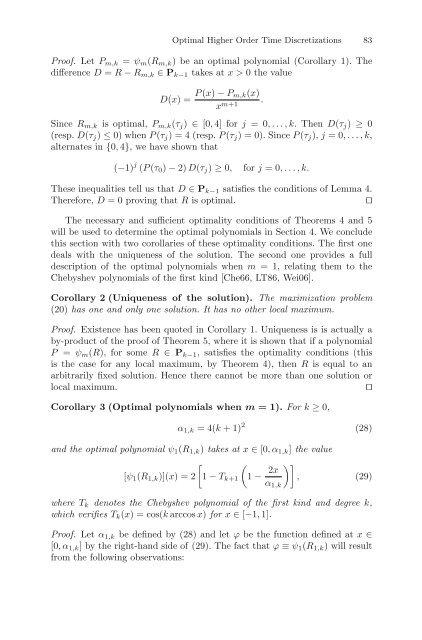Partial Differential Equations - Modelling and ... - ResearchGate
Partial Differential Equations - Modelling and ... - ResearchGate
Partial Differential Equations - Modelling and ... - ResearchGate
You also want an ePaper? Increase the reach of your titles
YUMPU automatically turns print PDFs into web optimized ePapers that Google loves.
Optimal Higher Order Time Discretizations 83<br />
Proof. Let P m,k = ψ m (R m,k ) be an optimal polynomial (Corollary 1). The<br />
difference D = R − R m,k ∈ P k−1 takes at x>0 the value<br />
D(x) = P (x) − P m,k(x)<br />
x m+1 .<br />
Since R m,k is optimal, P m,k (τ j ) ∈ [0, 4] for j =0,...,k.ThenD(τ j ) ≥ 0<br />
(resp. D(τ j ) ≤ 0) when P (τ j ) = 4 (resp. P (τ j )=0).SinceP (τ j ), j =0,...,k,<br />
alternates in {0, 4}, we have shown that<br />
(−1) j (P (τ 0 ) − 2) D(τ j ) ≥ 0,<br />
for j =0,...,k.<br />
These inequalities tell us that D ∈ P k−1 satisfies the conditions of Lemma 4.<br />
Therefore, D = 0 proving that R is optimal.<br />
⊓⊔<br />
The necessary <strong>and</strong> sufficient optimality conditions of Theorems 4 <strong>and</strong> 5<br />
will be used to determine the optimal polynomials in Section 4. We conclude<br />
this section with two corollaries of these optimality conditions. The first one<br />
deals with the uniqueness of the solution. The second one provides a full<br />
description of the optimal polynomials when m = 1, relating them to the<br />
Chebyshev polynomials of the first kind [Che66, LT86, Wei06].<br />
Corollary 2 (Uniqueness of the solution). The maximization problem<br />
(20) has one <strong>and</strong> only one solution. It has no other local maximum.<br />
Proof. Existence has been quoted in Corollary 1. Uniqueness is is actually a<br />
by-product of the proof of Theorem 5, where it is shown that if a polynomial<br />
P = ψ m (R), for some R ∈ P k−1 , satisfies the optimality conditions (this<br />
is the case for any local maximum, by Theorem 4), then R is equal to an<br />
arbitrarily fixed solution. Hence there cannot be more than one solution or<br />
local maximum.<br />
⊓⊔<br />
Corollary 3 (Optimal polynomials when m =1).For k ≥ 0,<br />
α 1,k =4(k +1) 2 (28)<br />
<strong>and</strong> the optimal polynomial ψ 1 (R 1,k ) takes at x ∈ [0,α 1,k ] the value<br />
(<br />
[ψ 1 (R 1,k )](x) =2<br />
[1 − T k+1 1 − 2x )]<br />
, (29)<br />
α 1,k<br />
where T k denotes the Chebyshev polynomial of the first kind <strong>and</strong> degree k,<br />
which verifies T k (x) = cos(k arccos x) for x ∈ [−1, 1].<br />
Proof. Let α 1,k be defined by (28) <strong>and</strong> let ϕ be the function defined at x ∈<br />
[0,α 1,k ] by the right-h<strong>and</strong> side of (29). The fact that ϕ ≡ ψ 1 (R 1,k ) will result<br />
from the following observations:
















